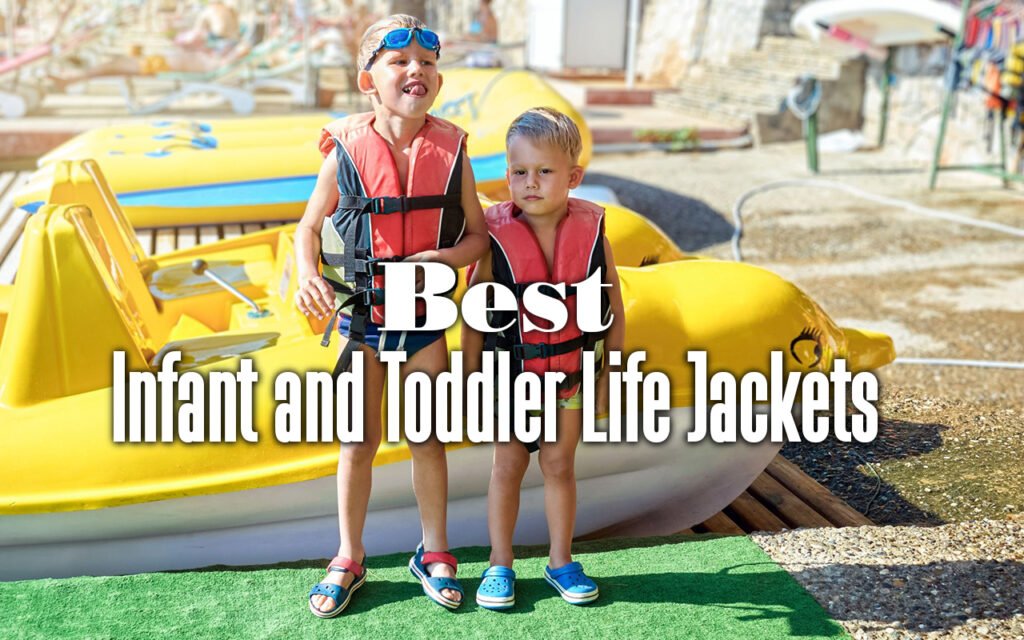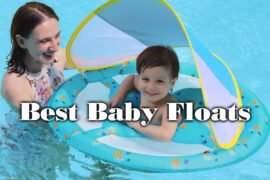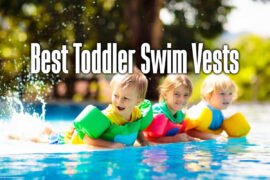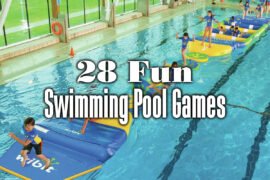What’s more exciting for a kid than playing in the water? But, at the same time, what is more, frightening to a parent? Check out the best infant and toddler life jackets that are effective, affordable, suitable for your kids, and make them swim well in water.
We all know that drowning is a serious risk for small children, but we also want them to enjoy the water as much as possible. The safest method to keep them safe is to have them wear a life jacket.
However, choosing one can be difficult. They are bulky and can be uncomfortable. Children often refuse to wear them; some do more than just keep your baby’s chin above water.
We’ve spoken with the professionals and collected our findings to answer your concerns about life jacket safety, including which types are ideal for each condition. We’ve looked high and low for the best kid’s life jackets on the market to make it simple to find one that is effective and affordable.
Our Top Picks
Best Infant and Toddler Life Jackets
Here are seven certified and safe infant and toddler life jackets.
1. Airhead Treasure Life Vest
This Airhead Treasure Life Vest is rated for kids under 30 pounds and comes with an adjustable buckle strap to keep you tight.
The foam collar gives your kid greater head and neck support both in and out of the water and an accessible grab strap, making it simple to rescue your kid from the water easily and quickly. This model is available in various designs and adorable cartoons.
- It has a grab strap for quick rescue.
- It’s brightly colored, so you will have no trouble finding your kid.
- The USCG-approved Type II Life Jacket assures you of its quality.
- It will not fit tiny kids.
2. O’Neill Infant USCG Vest
Safety comes first if you’re taking your child out into the ocean. A life jacket will swiftly flip your infant onto their back and keep their face out of the water, avoiding drowning if there is an accident.
They can quickly be located and pulled from the water between the bright colors and the attached grab strap.
Reviewers agree that their kids found it comfortable, and the crotch strap keeps them safe and secure. You will be able to customize the size and get the life jacket as snug and safe as possible with the dual-fasten zipper and adjustable buckle.
- It’s a high-quality design.
- Designed to facilitate face-up flotation.
- Brightly colored for easy recovery.
- The crotch strap keeps the jacket from slipping off.
- Limited color option.
- Not suitable for ocean use.
- It can only be used for children up to 30 pounds.
3. Stohlquist Infant PFD Life Jacket
This model has two foam neck supports, just like the previous model.
Stohlquist improved the foam flap design by adding an extra foam pad to provide additional support for tiny infants.
It comes with a clip, adjustable strap for added protection, and an easy-to-use zipper. It also includes a crotch strap to keep it from slipping over your baby’s head.
The Coast Guard-approved protection and lightweight design of this Life Jacket give you superior safety to most other life jackets.
- It’s available in bright yellow.
- The grab strap is easy to use and strong.
- It has a buckle and strap for a snug fit.
- It includes dual neck support to keep your child’s face out of the water.
- It was expensive.
- Zippers can rub on a child’s neck or face.
4. Salus Bijoux Baby Vest
You want your baby to cool off by getting in the water on a hot summer day, but heavy, plastic life jackets can actually cause them a lot of trouble if they get too hot. This life jacket will keep your baby cool if you want to keep them secure but plan on keeping them in the sand for most of the day.
It includes a webbing harness system and an adjustable mesh to increase airflow and prevent heavy plastic fabrics from rubbing against the skin. The mesh back allows your baby to lie down comfortably in a baby carrier or even on a blanket.
It is designed for babies between 9 and 25 pounds and features a three-piece collar design with extra flotation to help keep your baby’s head up. This life jacket will assist keep them cool and safe if you love to hit the beach with your baby for extended periods.
- The extra flotation near the head is extra comfortable.
- Without back padding, it’s less bulky, making it easier for your baby to hold.
- The mesh and webbing harness keeps your baby cool on the hottest of days.
- When it comes to putting on the mesh harness correctly, some parents may find it difficult.
5. Stearns Infant Classic Series Vest
Sometimes the simple is the best when it comes to infant and toddler life jackets. This Stearns model has a timeless vest design and various features, making it perfect for infants. This is an affordable and sure choice if your little swimmer is just starting out.
This US Coast Guard-approved jacket helps babies under 30 pounds stay afloat with a durable nylon shell and PE flotation foam inside. There’s even a grab handle and leg strap for added protection. You may grab your child immediately without worrying about anything breaking or slipping if they have a frightening moment in the water.
The combination of flotation foam and head support is also appreciated. The addition of a life jacket can boost your baby’s confidence and help them feel more comfortable in the water. This is a perfect option that will last for years to come if you want to start swimming lessons with your little ones.
- The simple and classic vest design is easy to take on and off.
- US Coast Guard approved with nylon shell and flotation foam.
- The grab handle lets you lift the baby out of the water in an emergency.
- Resizing can be tricky, so make sure the life jacket isn’t too tight or loose.
6. Stearns PFD 2000013194 Jacket
This snug-fitting device has a buckle enclosure with a comfortable polyester liner, which keeps it much trimmer than your typical life jacket, making it ideal for splashing in the pool.
The neck flap is intended to keep your baby’s head above the water in case your baby falls. It’s perfect for infants weighing less than 30 pounds. If you want to go on a boat, this design is bright green, so you’ll be able to see it well. It’s also Type II Coast Guard-approved, so it meets legal standards.
- Sturdy construction.
- Far less bulky than other models.
- It will flip your baby onto its back.
- Brightly colored design is more visible.
- It might be a bit heavy.
- The neck hole is a little small.
7. Stearns Original Puddle Jumper Kids Life Jacket
You might want to try this Stearns Puddle Jumper if you have ever had a kid refuse to put on his life jacket because it was heavy and uncomfortable.
It’s not like a regular life jacket, but it is US Coast Guard-approved (Type V with type III performance) and safe since it wraps around the torso and upper arms.
This choice will help your swimmer’s head stay above water while keeping their torso weight free.
Swimming aids will also be provided so that they may freely practice their swimming stroke while still feeling what it’s like to raise their torso to the top of the water on their own.
- It’s not heavy.
- The kids can maintain a natural swimming position.
- Kids are happier wearing this comfortable design.
- There’s no grab strap.
- It is unsuitable for infants or toddlers under 30 pounds.
Do Infants and Toddlers need to wear Life Jackets?
Drowning is the world’s leading cause of accidental death. Children ages 1-4 and those ages 5-9 are at a higher risk of drowning death than any other age group.
Wearing life jackets while in and around the water is your child’s best protection against drowning when combined with adequate adult supervision.
Even if your infants know how to swim, wearing a life jacket in a pool or boat is an excellent precaution. The life jacket can prevent them from slipping beneath the water if a child experiences fatigue without you noticing.
While boating, a good baby float or a life jacket suited to their age and size can keep them safe afloat if an emergency were to happen and you or your child were to lose consciousness. It can even flip them face-to-face until help arrives, depending on the jacket’s design.
It’s also the law and provides life-saving protection to your kid. Finally, life jackets allow your child to enjoy all of the excitement and fun that the water has to offer, which will help them develop confidence in safely watering them.
You want them to be well acquainted with and love the water, and don’t be afraid of it as your child grows and is old enough to learn to swim. Wearing a life jacket while your child is young will not only keep them safe in the water but will also help them develop their interests.
How does Life Jacket protect my child?
Infant and Toddler Life Jackets protect their wearers in several ways:
- Buoyancy: They’re filled with a highly buoyant material (usually foam) that displaces a lot of water for its weight and size, keeping the wearer afloat.
- Visibility: A toddler life jacket may be visible to your child in an emergency, depending on your chosen color. The top colors include yellow, orange, and red. Stay away from gray, blue, and other dull colors.
- Head Protection: Some models are meant to flip children onto their backs, so their faces stay above water. This is a perfect alternative if you want to keep your little one safe while swimming or any other water activity that may result in the user falling unconscious and unable to flip over.
- Security: Most children’s life jackets come with a crotch strap to keep them from sliding off if a youngster falls into the water, despite being non-approved floatation devices.
Types of Infant and Toddler Life Jackets
There are different types of Infant and Toddler Life Jackets. These can be confusing, but here is what you need to know:
- Type I: The following life jackets are designed for offshore ocean use in rough and unpredictable water. They’re pretty efficient for flotation, but they’re uncomfortable and heavy. Finding Type I jackets for children is difficult.
- Type II: This is the type you’re most likely to come across when purchasing a life jacket for your child. Type IIs are best suited for use in calmer water and are used when fishing or boating. These are less buoyant than Type I but are also less heavy, making them more comfortable and unsuitable for rough waters.
- Type III: Type III are less buoyant than Type II life jackets. They’re best for well-supervised water activities such as kayaking or canoeing where rescue might be on the way, and they won’t turn the wearer over when they fall into the water. These are widely available in kid’s sizes.
- Type IV: These throwable devices (such as life savers or life rings) are thrown overboard to a person in distress. They are not suitable for children to rely on as they would need to walk and swim in the water before being able to reach the device.
- Type V: These are specialized life jackets designed for kayaking, windsurfing, and sailing that need to be done in water. Some are made to inflate once they enter the water. A Type V is unlikely to be necessary if you’re buying a life jacket for your child’s regular water usage.
How to Select the Best Life Jacket for Kids
Make sure you get the following things when purchasing a life jacket:
US Coast Guard Approval
There should also be an indication that the life jacket is licensed by the US Coast Guard, with all of the restrictions (recreational watercraft, personal watercraft, commercial usage, etc.) under which it may be approved.
Weight Restrictions
The inside of the bag also has a label with the weight limits. Pick one for the child’s current weight. Do not be tempted to buy one bigger than your baby with the hope that you can use it for longer. Your child’s safety is paramount, so the jacket must meet their immediate needs.
Color
Visibility is essential for rapid recovery if an emergency were to arise when your child is boating or out on the open water. Select brightly-colored jackets that contrast with the blue or green water. Avoid grays and blues.
Choose jackets in bright colors that contrast with the green or blue water. Red, yellow, and orange colors are good choices and should be avoided in blues and grays.
Grab Strap
A grab strap is a perfect safety feature if you plan to go boating. The foam handle is a great safety feature as you can grab it to pull your child back into the boat easily if they fall in the water.
Security
The life jacket you choose must be secure. Some come with a crotch strap that prevents the jacket from slipping over your child’s head. If it does not have a strap, you can test its safety by lifting your child by the shoulders of the jacket; If it doesn’t come over their ears, it’s comfortable enough.
Is There Anything Else I Should Know?
The life jacket is the best way to keep your baby safe in the water. However, they must be worn for them to work. “Infant” life vests are available in sizes ranging from 8 to 30 pounds, which is a big size range that may make it difficult to obtain one for the tiniest of infants.
While there is no law against taking an infant on boats, if you plan to go boating with your infant and toddler, you should be aware of US Coast Guard recommendations:
Babies vary widely in size, but few are well over a year before they reach the 18-pound mark. If you plan on taking your tiny baby on a boat, make sure you test your life jacket, which is also known as a personal flotation device, as per the Coast Guard recommendations.
According to the Coast Guard, taking infants on a recreational boat is not recommended. The PFDs are currently available for newborns up to 18 pounds and may be unsuitable for them to perform as expected. They would not know if that device will float their child with their head out of the water unless the parent can test their newborns out in a PFD sized for infants in a swimming pool. Make sure you have a working PFD for your infant. “We do not recommend allowing your kid to ride in a boat on the water without taking additional precautions.”
A baby varies widely in size, but some are over a year old before reaching the 18-pound mark. If you’re going on a boat with your tiny kid, follow the Coast Guard’s guidelines to ensure your life jacket (also known as a personal flotation device) is suitable.
Bottom Line
While we appreciate the Puddle Jumper’s comfort and design, overall safety trumps all else, making the Stohlquist Unisex the top pick for the best baby life jacket.
It has all the safety features you could want — crotch straps, neck support, grab strap, and a bright color that won’t weigh you down – all wrapped in a sleek, non-bulky design that’s US Coast Guard-approved. This life jacket design also makes it easier to use, and not just that, but it’s also more comfortable than most of the other options.
There are a lot of adorable and flashy life jackets on the market today, but don’t let them divert you away from the essential safety features you require because that’s the only thing that matters in an emergency.
FAQs
1. What type of life jacket should 2-year-old wear?
The average 1-year-old would fit an infant-sized jacket (up to 33 pounds) under the United States Coast Guard’s (USCG) current classifications. The average 2-year-old will still fit an infant size, although babies at the higher end can fit a toddler size (33-55 pounds).
2. Do Infant and Toddler Life Jackets expire?
There is no expiration date for a personal flotation device and lifejacket, but it becomes void if it has been altered or repaired. Therefore, it must be replaced and discarded for recycling, which is no longer usable.
3. What is the difference between Type I, II, and III life jackets?
Type I PFDs are available in three designs: inherently buoyant, inflatable, and hybrid. A Type II PFD is designed for still waters where a rapid rescue is expected. The majority of the boats that you will encounter are Type II. They have a simple design and are less bulky than Type I, but they are not as comfortable as Type III.
4. Which color life jacket is best?
In a search and rescue scenario, color is essential for easy identification. Red, orange, and yellow are the most bright colors for these life jackets. Some life jackets also include reflective tape to enhance visibility.
5. What is the smallest life jacket made?
The ploota, which is only 1/50th the size of a regular foam-based life jacket, is tiny and takes up 50 times less space than average life jackets. Another exciting aspect is that the device is very light, weighing only 280 grams and allowing users to participate in high-intensity water sports.







